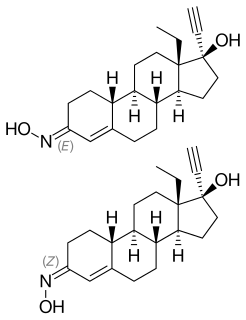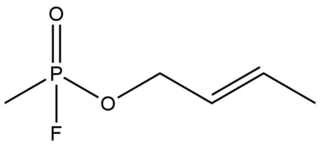
The Beckmann rearrangement, named after the German chemist Ernst Otto Beckmann (1853–1923), is a rearrangement of an oxime functional group to substituted amides. The rearrangement has also been successful performed on haloimines and nitrones. Cyclic oximes and haloimines yield lactams.

An oxime is a chemical compound belonging to the imines, with the general formula RR'C=NOH, where R is an organic side-chain and R' may be hydrogen, forming an aldoxime, or another organic group, forming a ketoxime. O-substituted oximes form a closely related family of compounds. Amidoximes are oximes of amides with general structure R1C(=NOH)NR2R3.
Obidoxime is a member of the oxime family used to treat nerve gas poisoning. Oximes are drugs known for their ability to reverse the binding of organophosphorus compounds to the enzyme acetylcholinesterase (AChE).
Phosgene oxime, or CX, is an organic compound with the formula Cl2CNOH. It is a potent chemical weapon, specifically a nettle agent. The compound itself is a colorless solid, but impure samples are often yellowish liquids. It has a strong, disagreeable odor and a violently irritating vapor.

Norelgestromin, or norelgestromine, sold under the brand names Evra and Ortho Evra among others, is a progestin medication which is used as a method of birth control for women. The medication is available in combination with an estrogen and is not available alone. It is used as a patch that is applied to the skin.
Nettle agents or urticants are a variety of chemical warfare agents that produce corrosive skin and tissue injury upon contact, resulting in erythema, urticaria, intense itching, and a hive-like rash.

Pralidoxime or 2-PAM, usually as the chloride or iodide salts, belongs to a family of compounds called oximes that bind to organophosphate-inactivated acetylcholinesterase. It is used to treat organophosphate poisoning in conjunction with atropine and either diazepam or midazolam. It is a white solid.
Bromobenzyl cyanide (BBC) is an obsolete lachrymatory agent introduced in World War I by the Allied Powers.
In enzymology, an oximinotransferase is an enzyme that catalyzes the chemical reaction

Milbemycin oxime is a veterinary drug from the group of milbemycins, used as a broad spectrum antiparasitic. It is active against worms (anthelmintic) and mites (miticide).

Asoxime chloride, or more commonly HI-6, is a Hagedorn oxime used in the treatment of organophosphate poisoning.

Phenaglycodol is a drug described as a tranquilizer or sedative which has anxiolytic and anticonvulsant properties. It is related structurally and pharmacologically to meprobamate, though it is not a carbamate.

Norethisterone acetate oxime, or norethindrone acetate oxime, is a steroidal progestin of the 19-nortestosterone group which was developed as a postcoital contraceptive but was never marketed. It is the C3 oxime and C17β-acetate ester of norethisterone.

Nisterime (INN), also known as 2α-chloro-4,5α-dihydrotestosterone 3-O-(p-nitrophenyl)oxime or as 2α-chloro-5α-androstan-17β-ol-3-one 3-O-(p-nitrophenyl)oxime, is a synthetic anabolic-androgenic steroid (AAS) and a derivative of dihydrotestosterone (DHT) that was never marketed. The C17α acetate ester of nisterime, nisterime acetate (ORF-9326), also exists and was developed as a postcoital contraceptive but was similarly never marketed.

P1-185, also known as progesterone 3-O-(L-valine)-E-oxime or as pregn-4-ene-3,20-dione 3-O-(L-valine)-E-oxime, is a synthetic progestogen and neurosteroid and an oxime ester analogue and prodrug of progesterone. It was developed as an improved water-soluble version of progesterone such that it could be formulated as an aqueous preparation and easily and rapidly administered intravenously as a potential therapy for traumatic brain injury. However, the chemical synthesis of P1-185 was described as somewhat challenging, so oxime conjugates of progesterone of the C20 instead of C3 position, such as EIDD-1723 and EIDD-036, have since been developed.
Progesterone oxime, or progesterone monoxime, is an oxime conjugate of progesterone and may refer to:

EA-2012 is an extremely toxic organophosphate nerve agent. It's an extremely potent acetylcholinesterase inhibitor that is resistant to atropine and oxime treatment.

EA-2098 is an extremely toxic organophosphate nerve agent. It is an extremely potent acetylcholinesterase inhibitor that is resistant to atropine and oxime treatment.

Crotylsarin (CRS) is an extremely toxic organophosphate nerve agent of the G-series. Like other nerve agents, CRS irreversibly inhibits the acetylcholinesterase. However, since the inhibited enzyme ages so rapidly, the inhibited enzyme can't be reactivated by oxime reactivators.













